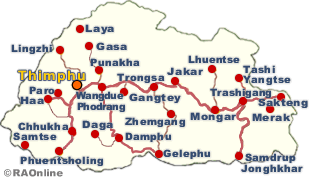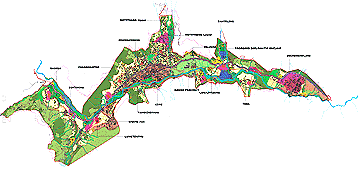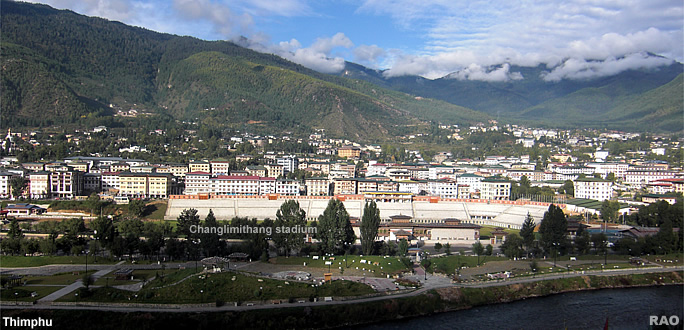 |
Bhutan Development |
|
 |
Bhutan Information |
|
|
 |
|
Planners
draw up a grand vision for the capital city |
 |
Thimphu
in 2027 - a city of 150,000 people with an environment that provides a
good quality of life with adequate space to work, drive, jog, cycle, picnic,
relax and be close to nature.
The
department of urban development and housing's US $1.00 billion structural
plan for Thimphu for the next 25 years will be presented to the government
in about a month. The plan outlines the overall development
of one of the fastest growing cities in this part of the world,
at seven to 10 percent. |
"There
is a lot of unplanned growth and ad-hoc development taking place here,"
the director general of DUDH, Tshering Dorji said. "The structural plan
aims to guide and control the growth of the city. It is not too late to
plan a good city." "The structural plan gives an overview of infrastructure
proposal, investment plans and land-use," DUDH's senior town plannersaid.
"It covers the geographical area from Changtagang in the north to Nabi
Rongchhu in the south. The forest line serves as the east-west boundary."
| 70
percent of the new municipal to keep as open space and green areas |
 |
The map of the extended Thimphu municipality
The
plan divides the new Thimphu municipality, extended under a directive of
the council of ministers in 1999, into 21 precincts or zones with a total
area of 26.5 square kilometers. It proposes that once a particular precinct
is designated for a certain purpose, it should serve only that use or purpose.
For instance, an area that has been marked as either agricultural or residential
precinct cannot be put to any other use. |
The
structural plan has identified "node points" - such as Taba and Babesa
- which will be self-contained neighbourhoods with good transport networks,
workshops, car-parks, schools, community halls, cinemas, restaurant and
shops. "About 20-30 percent of the new municipal area will be developed
to accommodate the projected population growth in the next 25 years," the
DUDH director general said. "The remaining 70 percent will be kept
as open space and green areas." A six-lane central urban corridor road,
to be part of the expressway, is also envisioned in the plan. A footpath
that goes around the entire municipal boundary is under consideration.
Thimphu would also serve as a cultural and heritage center. "The city's
traditional and cultural heritage will be kept intact," the town planner
says. Places like Changangkha, Trashichhodzong and Dechenphodrang will
be protected and promoted as heritage precincts. "Existing traditional
buildings within the municipal boundary and the surrounding regions will
be preserved and traditional architecture will be promoted," the planner
said. "
| Traditional
buildings within the municipal boundary and the surrounding regions will
be preserved |
"Existing
traditional buildings within the municipal boundary and the surrounding
regions will be preserved and traditional architecture will be promoted,"
the planner said. "All new buildings will be required to incorporate the
elements of traditional architecture. We will now be more vigorous and
firm in implementing this rule which was often violated in the past." One
of the tenets of the plan is that nature will be respected. All important
water bodies are listed for protection. No construction will be allowed
within 30 metres on either side of a river or stream.
 |
This
corridor will be turned into green areas. "We do not want our capital to
be a concrete jungle but a comfortable city which is closest to nature,"
Tshering Dorji said. The broad conceptual objective of the structural plan
is to develop Thimphu along with the adjoining districts. Paro, Punakha
and Wangduephodrang have together been identified as the national capital
region. The biggest hurdle for the DUDH, today, is getting powerful Thimphu
landowners to accept the plan. About 25-30 percent of the registered landholdings
will be taken as land pool under the provisions of the plan.
This proposal,
along with guided land development, is likely to fray many nerves and raise
hackles. "This is a draft plan," the Thimphu Thrompon said. "We still need
to have further discussions with the town committee, other organisations,
and the stakeholders. We need everyone's feedback, suggestions, support
and acceptance." He said that residents would have to be prepared to place
the societal and larger common benefits before personal ones.
"This definitely
would mean displeasing a few individuals," the Thrompon said. "But we will
have to make sacrifices. Some day we will all be proud of our city." The
director general of DUDH said that the department would do its best to
ensure that no one was displaced and that one person's loss did not benefit
another individual. "Everything will be for the good of our capital city
and the people of Bhutan," he said. "But we are also prepared to accept
that we cannot produce a plan which everyone will like.".
| This
article was contributed by KUENSEL, Bhutan's National Newspaper 2002 |
 |
| Information on Bhutan |
 |
|




